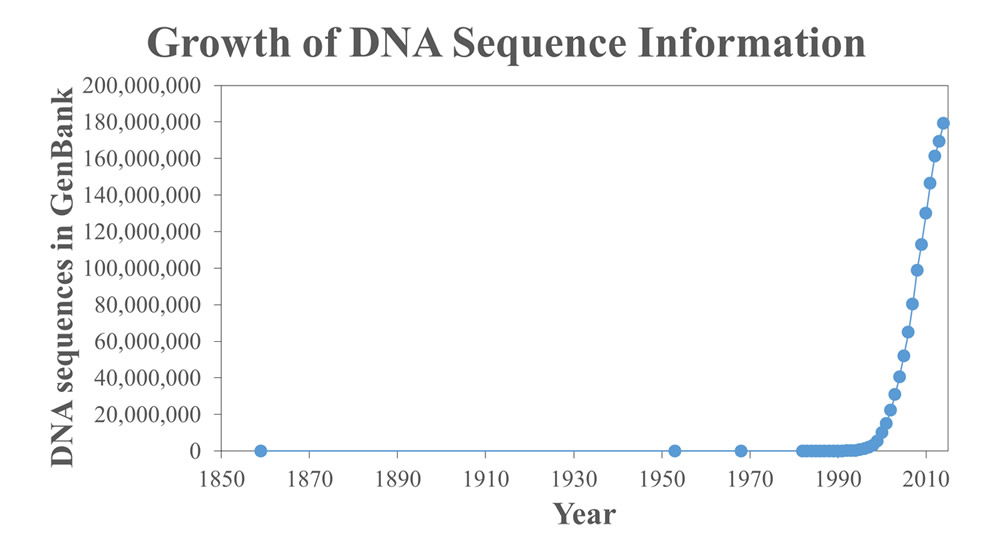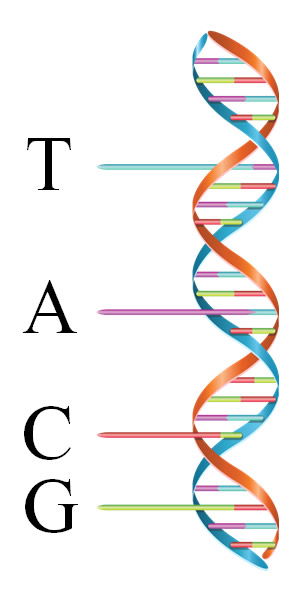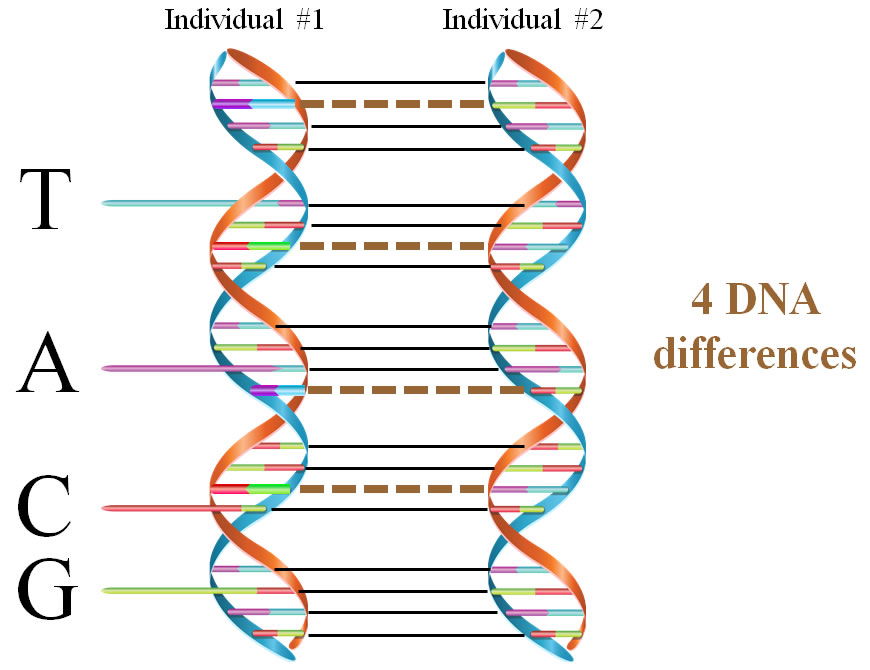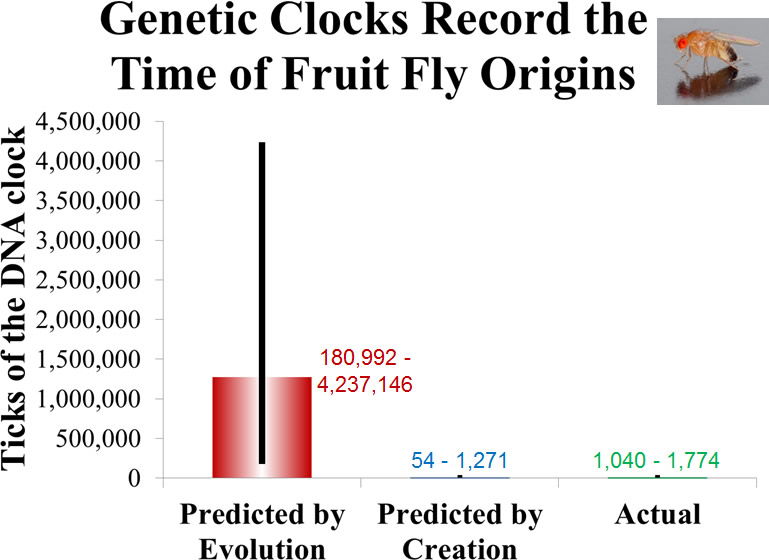
A Spectacular Confirmation of Darwin’s Argument—for Genesis
In previous articles, we observed that just a few thousand animals likely accompanied Noah on the Ark. From these creatures, a myriad of species arose.
In response to the question of how this might be possible, we took a cue from Darwin’s own work. We observed that the comparison of breeds to species indicated that species must have arisen recently—within thousands of years, not millions of years.
What Darwin didn’t know is that his indirect evidence would be spectacularly confirmed over 150 years later.
The century and a half wait was a consequence of a long-standing secret in the evolutionary community—the massive risk that Darwin took when he wrote On the Origin of Species. In arguing for a particular view of the origin of species, Darwin put his entire explanatory edifice in great danger. Since species are defined by traits and characteristics that are heritable, the origin of species is a fundamentally genetic question. In other words, we recognize zebra species because the information that specifies stripes is inherited consistently generation after generation. Elephants are an iconic species because their iconic feature—their long trunk—is present in each generation. In short, the concept of species exists because genetics exists.
When Darwin wrote his book in 1859, genetics wasn’t even a scientific field. The father of modern genetics, Gregor Mendel, hadn’t even published his foundational observations in pea plants. Mendel’s findings wouldn’t be announced until 1865, and then Mendel’s work would be lost for several decades. Only at the turn of the century, after genetics was connected to cellular structures termed chromosomes, was the term genetics coined.

When cells divide, the genetic material takes the form of chromosomes, depicted as a blue X-like structure. Chromosomes are composed of coils of a substance termed chromatin. Chromatin can be further divided into units called nucleosomes, which consist of DNA wrapped around a group of protein molecules called histones. The individual strands of DNA are composed of a series of chemical units abbreviated with the letters A, T, G, and C. Image by Wikipedia Commons.
While the chromosome link moved the field of genetics forward, it also sparked a new debate. Since chromosomes are composed of two major molecules (DNA and protein), geneticists would debate which molecule was the substance of heredity for another several decades. Finally in 1953, when Watson, Crick, and colleagues discovered the structure of DNA, scientists finally settled on DNA as the molecule possessing the heritable genetic information.
Like so many scientific discoveries, the elucidation of the structure of DNA concluded one scientific story and started another. With this newfound knowledge, the scientific community could now go about the business of finding out the sequence of the DNA code in each species. Again, this information was slow in coming. Only in the last few years has enough DNA sequence existed in the public databases whereby Darwin’s origin claims can be directly evaluated.1

Long lag followed by rapid growth in DNA sequence information. The first three blue dots respectively represent (1) the year (1859) Darwin published On the Origin of Species; (2) the year (1953) the structure of DNA was solved; and (3) the year (1968) the first DNA sequence was published. Adapted with permission from Dr. Nathaniel T. Jeanson and Dr. Jason Lisle, “On the Origin of Eukaryotic Species’ Genotypic and Phenotypic Diversity,” Answers Research Journal 9 (2016): 82–83, figure 1 and supplemental table 1, https://answersingenesis.org/natural-selection/speciation/on-the-origin-of-eukaryotic-species-genotypic-and-phenotypic-diversity/.
To clarify, no other scientific field directly records a species’ ancestry. Fossils, geography, anatomy, and physiology are not inherited. DNA is the actual chemical that is passed on in sperm and egg. Hence, only the field of genetics acts as a direct record of species’ ancestry.
Conversely, by virtue of the manner in which DNA changes each generation, DNA also records the passage of time.
To understand how the DNA clock ticks, it’s helpful to understand the structure of the DNA molecule. DNA exists in the form of a twisted ladder. Each rung of the ladder represents a chemical letter, and the different colors of the rungs represent the different DNA letters.

The twisted, ladder-like structure of DNA. The rungs of this ladder represent the fundamental units, or base-pairs of DNA, which come in four varieties and are abbreviated by the letters A, T, G, and C. The specific ordering of these letters and the total number of rungs specifies each creature’s unique identity. Image by Askold Romanov, via Getty Images.
Though only four different DNA letters exist in the DNA code, this small chemical alphabet of sorts can carry tremendous amounts of information. For example, in humans, a total of six billion DNA letters—rungs of the ladder—exist in each person.2 The arrangement of these letters—their order, their spatial relationship to other letters, and so on—carries the information for a species’ traits and characteristics.
When sperm and egg copy their DNA in preparation for fertilization, the copying process is imperfect. In terms of the diagram we just examined, copying errors change the color of one of the rungs to a different rung color. Over time, the number of color-changed rungs increases, acting like a clock that measures time since the DNA sequence first came to be.
By comparing the rungs of the DNA ladder in various individuals, we can assess how long ago this event was. For example, by comparing the rungs between any two humans, we can estimate how many generations ago two people shared a common relative, like a great-great-great-great-grandfather. It so happens that the vast majority of our DNA rungs are the same, making these comparative analyses straightforward.

How “ticks” of the DNA “clock” are measured. When DNA is copied in sperm and egg, the rungs of the DNA ladder are sometimes copied imperfectly, resulting in the change of the identity of one or more of the rungs from one color to another. Over time, these mistakes are additive and accumulate. Thus comparison of the rungs of two DNA sequences reveals how many ticks of the DNA clock have passed since these two individuals last shared a common ancestor. Image by Askold Romanov, via Getty Images.
For technical reasons that will be explained in a subsequent post, only a small subset of the DNA letters in an individual lend themselves as simple timekeepers.3 In particular, a subset of DNA termed the mitochondrial DNA acts as a very straightforward timekeeper. Mitochondrial DNA encodes some of the most important and basic information for our bodies to function. Without mitochondrial DNA, we would be unable to convert the food we eat into energy usable to our cells. In other words, without mitochondrial DNA, human and animal life largely stops.
Comparing the rungs of the mitochondrial DNA ladder among various species reveals a stunning result. If species have been in existence for millions of years, a large number of the mitochondrial DNA rungs should have a different color. In contrast, the vast majority of these rungs are the same.4 It’s as if species originated recently, in the last few thousand years. In other words, if species originated within the last 6,000 years, very few ticks of the mitochondrial DNA clock would have occurred, and this is exactly what we observe.

Predicted versus actual ticks of the human DNA clock that exists in a specialized compartment (organelle) of the cell termed mitochondria. The height of the red bar shows the minimum evolutionary prediction; the height of the blue bar shows the maximum creation prediction. A range of actual ticks of the DNA clock exists in the human population, and the height of the green bar shows the maximum number of ticks found. Graph adapted with permission from Dr. Nathaniel T. Jeanson, “On the Origin of Human Mitochondrial DNA Differences, New Generation Time Data Both Suggest a Unified Young-Earth Creation Model and Challenge the Evolutionary Out-of-Africa Model,” Answers Research Journal 9 (2016): 129, figure 2, https://answersingenesis.org/genetics/mitochondrial-dna/origin-human-mitochondrial-dna-differences-new-generation-time-data-both-suggest-unified-young-earth/.

Predicted versus actual ticks of the roundworm DNA clock that exists in mitochondria. The height of the red bar shows the average evolutionary prediction, and the numbers next to this bar show the maximum possible range of predictions (in technical statistical terms, the 95% confidence interval), depicted by the black bar. The height of the blue bar shows the average creation prediction, and the numbers next to this bar show the maximum possible range of predictions (in technical statistical terms, the 95% confidence interval), depicted by the black bar. A range of actual ticks of the DNA clock exists among roundworm species, and the height of the green bar shows the average number of ticks found, with the range shown in the numbers displayed above the bar. Graph adapted with permission from data in Dr. Nathaniel T. Jeanson, “Mitochondrial DNA Clocks Imply Linear Speciation Rates Within ‘Kinds,’” Answers Research Journal 8: https://answersingenesis.org/natural-selection/speciation/clocks-imply-linear-speciation-rates-within-kinds/ and in Dr. Nathaniel T. Jeanson, “Recent, Functionally Diverse Origin for Mitochondrial Genes from ~2700 Metazoan Species,” Answers Research Journal 6 (2013): https://answersingenesis.org/genetics/mitochondrial-dna/recent-functionally-diverse-origin-for-mitochondrial-genes-from-~2700-metazoan-species/. Image of roundworm by Bob Goldstein, via Wikimedia Commons.

Predicted versus actual ticks of the fruit fly DNA clock that exists in mitochondria. The height of the red bar shows the average evolutionary prediction, and the numbers next to this bar show the maximum possible range of predictions (in technical statistical terms, the 95% confidence interval), depicted by the black bar. The height of the blue bar shows the average creation prediction, and the numbers next to this bar show the maximum possible range of predictions (in technical statistical terms, the 95% confidence interval). A range of actual ticks of the DNA clock exists among fruit fly species, and the height of the green bar shows the average number of ticks found, with the range shown in the numbers displayed above the bar. Graph adapted with permission from data in Dr. Nathaniel T. Jeanson, “Mitochondrial DNA Clocks Imply Linear Speciation Rates Within ‘Kinds’,” and “Recent, Functionally Diverse Origin for Mitochondrial Genes from ~2700 Metazoan Species.” Image of fruit fly by André Karwath, via Wikimedia Commons.

Predicted versus actual ticks of the water flea DNA clock that exists in mitochondria. The height of the red bar shows the average evolutionary prediction, and the numbers next to this bar show the maximum possible range of predictions (in technical statistical terms, the 95% confidence interval), depicted by the black bar. The height of the blue bar shows the average creation prediction, and the numbers next to this bar show the maximum possible range of predictions (in technical statistical terms, the 95% confidence interval). A range of actual ticks of the DNA clock exists among water flea individuals, and the height of the green bar shows the maximum number of ticks found. Graph adapted with permission from data in Dr. Nathaniel T. Jeanson, “Mitochondrial DNA Clocks Imply Linear Speciation Rates Within ‘Kinds’,” and “Recent, Functionally Diverse Origin for Mitochondrial Genes from ~2700 Metazoan Species.” Image of water flea by Paul Hebert, via Wikimedia Commons.
Thus, by two independent lines of evidence, species look as if they originated recently. First, by Darwin’s own breed-species comparison and criteria, species must have originated contemporary with intelligent human populations. Second, when we examine the direct genetic record of their origin, we see very few genetic differences—far too few for species to have arisen over millions of years—but just the right amount if they originated within the last few thousand years.
Not surprisingly, evolutionists have tried to rebut this contradictory evidence. But their claims are vacuous.5 For example, in geology, a variety of techniques are used to argue against a 6,000 years age for the earth. From carbon-14 dating, to other forms of radioisotope dating, to ice core formation, to the rates of erosion, geologists see many lines of evidence inconsistent with the biblical view.
However, in order to make their millions-of-years math work, evolutionists have to assume constant rates of change. In carbon-14 dating, they have to assume that the rate of carbon-14 decay has been largely constant.6 When dating ice cores, they have to assume a roughly constant rate of ice layer formation. Erosion rates must be assumed to be constant with time for the argument against the Scriptures to hold any water.
Yet in the field of genetics, constant rates of change produce the opposite result—a tremendously strong argument for the recent origin of species, which, by implication, argues for a recent origin of the earth. How will the evolutionists deal with this conundrum?
For several reasons, invoking changing rates in genetics will not work. First, in light of the evolutionists’ historical rebuttals to young-earth creation geology, changing rates in genetics would be hypocritical. For years, young-earth creationists have argued for variable rates in geology, especially in light of the global Flood that was recorded in Genesis 6–8.7 In response, evolutionists have simply asserted that a global Flood—that changing rates—must simply not be invoked. It would be inconsistent to now suddenly permit changing rates to be arbitrarily invoked in a different field of science.
Second, under the evolutionary timescale, the required rates of genetic change are so low that they amount to a biological miracle.8 Since evolutionists forbid miracles from biological explanations, variable rates of genetic change are a nonstarter.
Despite the rigorous challenge that these data present to the evolutionary model, these two arguments for the recent origin of species leave an element of the young-earth model dangling—they still do not answer the question of how species originated.
But they do hold a tantalizing clue.
Footnotes
- Nathaniel T. Jeanson and Jason Lisle, “On the Origin of Eukaryotic Species’ Genotypic and Phenotypic Diversity: Genetic Clocks, Population Growth Curves, and Comparative Nuclear Genome Analyses Suggest Created Heterozygosity in Combination with Natural Processes as a Major Mechanism,” Answers Research Journal 9 (2016): 81–122, https://answersingenesis.org/natural-selection/speciation/on-the-origin-of-eukaryotic-species-genotypic-and-phenotypic-diversity/.
- DNA actually comes in duplicate. Each parent supplies one copy—or 3 billion DNA letters (rungs of the ladder). Thus, each person has two copies of 3 billion DNA letters, or 6 billion total DNA letters.
- Technically, all DNA sequence has the potential to act as a timekeeper. But the molecular details of the various sections of the DNA code make the manner in which time is kept a more complicated process for some parts of DNA, and a simple process for other parts.
- Nathaniel T. Jeanson, “Recent, Functionally Diverse Origin for Mitochondrial Genes from ~2700 Metazoan Species,” Answers Research Journal 6 (2013): 467–501, Recent, Functionally Diverse Origin for Mitochondrial Genes from ~2700 Metazoan Species; Nathaniel T. Jeanson, “Mitochondrial DNA Clocks Imply Linear Speciation Rates Within “Kinds,” Answers Research Journal 8 (2015): 273–304, https://answersingenesis.org/natural-selection/speciation/clocks-imply-linear-speciation-rates-within-kinds/; Nathaniel T. Jeanson, “A Young-Earth Creation Human Mitochondrial DNA ‘Clock’: Whole Mitochondrial Genome Mutation Rate Confirms D-Loop Results,” Answers Research Journal 8 (2015): 375–378, https://answersingenesis.org/genetics/mitochondrial-genome-mutation-rate/; Nathaniel T. Jeanson and Jason Lisle, “On the Origin of Eukaryotic Species’ Genotypic and Phenotypic Diversity: Genetic Clocks, Population Growth Curves, and Comparative Nuclear Genome Analyses Suggest Created Heterozygosity in Combination with Natural Processes as a Major Mechanism,” Answers Research Journal 9 (2016): 81–122, https://answersingenesis.org/natural-selection/speciation/on-the-origin-of-eukaryotic-species-genotypic-and-phenotypic-diversity/; Nathaniel T. Jeanson “On the Origin of Human Mitochondrial DNA Differences, New Generation Time Data Both Suggest a Unified Young-Earth Creation Model and Challenge the Evolutionary Out-of-Africa Model,” Answers Research Journal 9 (2016): 81–122, https://answersingenesis.org/genetics/mitochondrial-dna/origin-human-mitochondrial-dna-differences-new-generation-time-data-both-suggest-unified-young-earth/.
- Nathaniel T. Jeanson, “New Genetic-Clock Research Challenges Millions of Years,” Acts & Facts 43, no. 4 (2014), http://www.icr.org/article/new-genetic-clock-research-challenges.
- In other words, they refuse to rigorously consider how a global Flood—the type of deluge specified in Genesis 6–9—could have altered this rate or the interpretation of their results.
- Obviously, a global Flood would produce enormous geologic effects. See “The Flood,” Answers in Genesis, https://answersingenesis.org/the-flood/.
- Nathaniel T. Jeanson, “Recent, Functionally Diverse Origin for Mitochondrial Genes from ~2700 Metazoan Species,” Answers Research Journal 6 (2013): 467–501, https://answersingenesis.org/genetics/mitochondrial-dna/recent-functionally-diverse-origin-for-mitochondrial-genes-from-~2700-metazoan-species/.
Recommended Resources

Answers in Genesis is an apologetics ministry, dedicated to helping Christians defend their faith and proclaim the good news of Jesus Christ.
- Customer Service 800.778.3390
- © 2024 Answers in Genesis




